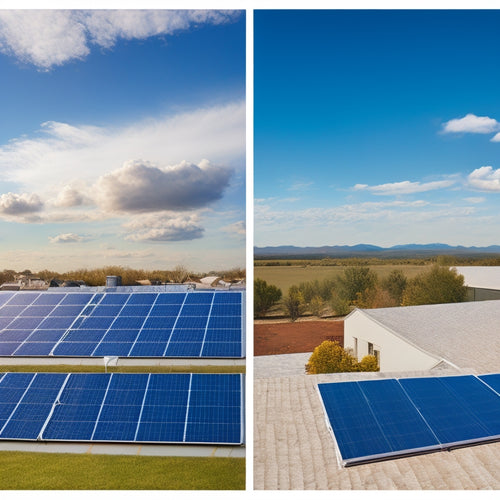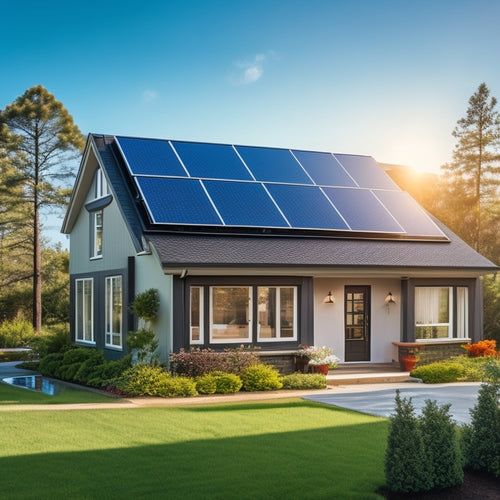
Insider Tips to Lower Solar Installation Prices
Share
You can greatly lower your solar installation costs by choosing the right panel type, optimizing your roof and site, and negotiating with multiple installers. Consider used or refurbished panels, which can save you up to 30% compared to new ones. Additionally, look into financial incentives, such as federal tax credits, state rebates, and utility programs. Improve your home's energy efficiency before installation to maximize savings, and prioritize panel quality, warranty, and installation technology. By following these insider tips, you'll be well on your way to reducing your solar installation prices - and there's even more to find out.
Key Takeaways
- Compare quotes from at least three installers to evaluate prices and services, and negotiate better pricing based on services provided.
- Consider used or refurbished panels, which can save up to 30% compared to new ones, but verify their quality and performance standards.
- Optimize energy efficiency in your home before solar installation by identifying and addressing energy consumption inefficiencies.
- Trim trees or remove obstructions to enhance sunlight exposure and optimize energy output, and ensure the roof can support solar panel weight.
- Take advantage of financial incentives like federal tax credits, state rebates, and utility programs to reduce upfront costs.
Know Your Solar Panel Options
What kind of solar panels are right for you? With so many options available, it's crucial to understand the different solar panel types and their panel efficiency to make an informed decision.
You'll want to take into account monocrystalline, polycrystalline, and thin-film solar panels, each with its unique characteristics. Monocrystalline panels offer high efficiency (up to 22%) but come at a higher cost. Polycrystalline panels are more affordable, with efficiency ranging from 15% to 17%. Thin-film panels are the most budget-friendly option, but their efficiency is lower (around 7-14%).
When evaluating solar panels, you should also take into account the wattage, voltage, and temperature coefficient. Higher wattage panels produce more power, while higher voltage panels are more efficient.
The temperature coefficient indicates how well the panels perform in high temperatures. Look for panels with a low temperature coefficient for best performance.
Optimize Your Roof and Site
Since you've selected the right solar panels, it's essential to verify your roof and site are refined for maximum energy production.
A thorough site assessment will help identify potential obstacles, such as shading from trees or neighboring buildings, that can impact your system's performance. Confirm your roof orientation is ideal for solar energy harvesting. A south-facing roof with a pitch between 30 and 40 degrees is typically the most suitable.
However, a skilled installer can work with less-than-ideal roof orientations to still achieve peak energy output. Consider trimming trees or removing obstructions to allow for maximum sunlight exposure.
Additionally, assess your roof's structural integrity to guarantee it can support the weight of the solar panels. By refining your roof and site, you'll be able to generate the most energy possible, reducing your reliance on the grid and saving you money in the long run.
Negotiate With Multiple Installers
How much are you willing to pay for your solar installation? One way to get the best deal is to negotiate with multiple installers. By doing so, you can compare prices, services, and installer reputations to find the best fit for your needs and budget.
| Installer | Price ($/Watt) | Reputation (Years in Business) | Warranty (Years) |
|---|---|---|---|
| Installer A | 2.50 | 10 | 25 |
| Installer B | 2.75 | 5 | 20 |
| Installer C | 2.30 | 15 | 30 |
| Installer D | 2.60 | 7 | 25 |
When negotiating, consider the following strategies:
- Get quotes from at least three installers to compare prices and services.
- Research each installer's reputation, checking online reviews, ratings, and years in business.
- Ask about warranties, maintenance, and repair services.
- Negotiate the price based on the quotes and services offered.
Look for Incentives and Rebates
After comparing quotes and services from multiple installers, you're likely to have a better understanding of the market rate for your solar installation.
Now, it's time to investigate incentives and rebates that can additionally reduce your costs. Federal tax credits, for instance, can provide a significant reduction in your tax liability.
Moreover, state rebates and local incentives can offer cash back or other benefits for going solar. You may also be eligible for utility programs that provide special rates or discounts for solar customers.
In addition, financing options and installation discounts from installers can help bring down your upfront costs. If you're unable to install solar on your property, consider community solar programs that allow you to purchase a portion of the energy generated by a nearby solar array.
Solar grants and energy audits can also provide beneficial savings. By taking advantage of these incentives, you can maximize the environmental benefits of solar energy while minimizing its cost.
Be sure to research and claim all the incentives you're eligible for to get the best possible deal.
Consider Used or Refurbished Panels
You can considerably reduce your upfront costs by considering used or refurbished solar panels, which can be a cost-effective alternative to brand-new ones.
However, it's crucial to verify that these panels meet your quality and performance expectations, which can be achieved through rigorous quality control measures.
Cost-Effective Panel Options
When considering solar installation, one of the most notable expenses is the cost of the panels themselves. You can greatly reduce this cost by exploring cost-effective panel options.
If you're on a tight budget, used or refurbished panels can be a viable solution for budget solar installations. These panels have been previously installed and removed, then refurbished to meet industry standards. They often come with warranties, providing you with added peace of mind.
Refurbished panels can save you up to 30% compared to new panels, making them an attractive option for those looking to reduce their upfront costs. However, it's crucial to verify the panels are certified by a reputable third-party organization and come with an extensive warranty.
Additionally, refurbished panels may have lower efficiency ratings, which could impact their overall performance. Assessing the pros and cons, used or refurbished panels can be a cost-effective solution for those looking to go solar without breaking the bank.
Quality Control Measures
The quality control measures for used or refurbished solar panels are critical to guaranteeing their performance and longevity.
You'll want to verify that the panels meet strict manufacturing standards, such as those set by the International Electrotechnical Commission (IEC). Confirm the panels come with installation certifications from reputable organizations, like the North American Board of Certified Energy Practitioners (NABCEP).
Conduct thorough quality assessments, including visual inspections and electrical testing, to identify any potential defects. Evaluate the warranty offered by the supplier, considering factors like duration, coverage, and transferability.
Perform panel testing to validate their performance under various conditions. Implement performance monitoring to track the panels' energy output over time.
Also, prioritize supplier transparency, researching their material sourcing and supply chain practices.
DIY Solar Installation Feasibility
Solar installation costs have long been a notable obstacle for individuals seeking to employ renewable energy, but recent advancements have made DIY solar installation a viable alternative.
You're likely wondering if taking on this project yourself is a practical option. The answer is yes, but it's essential to acknowledge the installation challenges that come with it.
You'll need to navigate local building codes, verify electrical connections are secure, and assure the system's overall performance. However, with the right DIY tools and a bit of determination, you can overcome these obstacles.
Start by researching local incentives and permits required for your project. Then, invest in a quality DIY solar installation kit, which usually includes pre-assembled components and detailed instructions.
Additionally, consider enlisting the help of a licensed electrician for the trickier aspects of the installation. By taking on some or all of the installation process, you can greatly reduce your overall costs, making renewable energy a more accessible and affordable option.
Energy Efficiency Upgrades First
You'll want to reduce your energy consumption fast by identifying areas of inefficiency in your home.
Next, enhance your home's insulation now to minimize heat loss and gain.
Reduce Energy Consumption Fast
Considering your current energy usage, it's essential to prioritize energy efficiency upgrades before investing in solar installations.
You'll be surprised at how much energy you can save by adopting simple habits and leveraging smart home technology. Start by identifying areas of inefficiency in your home, such as outdated lighting and appliances. Replace them with energy-efficient alternatives, like LED bulbs and Energy Star-rated appliances.
Next, focus on developing energy-saving habits. Make it a habit to turn off lights, electronics, and appliances when not in use. Adjust your thermostat to use less energy for heating and cooling. These small changes can add up to significant energy savings over time.
Invest in smart home technology, such as smart thermostats and power strips, to optimize your energy usage.
These devices can help you monitor and control your energy consumption in real-time, making it easier to identify areas for improvement. By reducing your energy consumption, you'll not only lower your energy bills but also reduce your reliance on the grid, making your solar installation more effective.
Enhance Home Insulation Now
How much heat escapes through your attic, walls, and floors? You might be surprised to learn that inadequate insulation is a significant contributor to energy loss in your home.
Before installing solar panels, it's crucial to address this issue to maximize their effectiveness.
Here's what you can do:
- Conduct an energy audit to identify areas of heat loss and gain
- Insulate your attic with fiberglass, cellulose, or spray foam insulation types
- Seal air leaks around doors, windows, and electrical outlets
- Upgrade your walls with insulation materials like fiberglass batts or rigid foam board
- Insulate your floors with foam board or reflective insulation
Optimize Energy Usage Today
By addressing insulation gaps, you've taken the first step towards maximizing your solar panel investment. Now, it's time to optimize your energy usage today.
To do this, start by conducting an energy audit to identify areas of inefficiency in your home. This will help you understand your energy usage patterns and pinpoint opportunities for improvement.
| Energy Efficiency Upgrade | Potential Savings |
|---|---|
| Replacing incandescent bulbs with LEDs | 50-75% |
| Upgrading to energy-efficient appliances | 20-30% |
| Installing smart power strips | 10-20% |
| Adding weatherstripping around doors and windows | 5-10% |
| Sealing air leaks in ducts | 10-20% |
Solar Panel Quality Matters
Three decades of solar panel manufacturing have led to a significant improvement in their quality, and today, you can choose from a wide range of solar panels with varying levels of efficiency, durability, and warranty.
When selecting solar panels, you should consider the following factors:
-
Panel Durability: Look for panels with a longer lifespan (25-30 years or more) and a durable design that can withstand extreme weather conditions.
-
Warranty Options: Check the warranty period (25 years or more) and what's covered, including performance, product, and labor.
-
Energy Output: Choose panels with high energy output per hour of sunlight, ensuring you generate enough power for your needs.
-
Brand Reputation: Research the manufacturer's reputation, reviewing their performance ratings, certifications, and customer feedback.
-
Price Comparison: Compare prices from different manufacturers, considering factors like panel quality, warranty, and installation technology.
Timing Is Everything in Solar
As you've carefully selected your solar panels, it's now important to contemplate the timing of your solar installation.
You see, timing is everything in solar, and being aware of current solar trends can greatly impact your installation prices. Installation seasons, for instance, can affect labor costs, with peak seasons typically resulting in higher prices.
Financial incentives, such as tax credits, can also influence your overall cost. Keep an eye on regional pricing, as it can vary greatly depending on local regulations, environmental impacts, and market competition.
Additionally, technological advancements can lead to more efficient systems, reducing costs over time. Government policies, like net metering laws, can also impact your installation costs.
As a buyer, it's essential to stay informed about local regulations, financial incentives, and market trends to negotiate the best price for your solar installation.
Frequently Asked Questions
Can I Install Solar Panels on a Rented Property?
You're worried about not owning the property, but don't let that stop you. You can still utilize solar power on a rented property by exploring solar lease options, which often require little to no upfront costs, and understanding your tenant rights.
How Long Does a Typical Solar Installation Project Take?
You'll typically spend 2-6 months from consultation to system activation, with the installation timeline divided into project phases: assessment, permitting, equipment delivery, installation, and final inspection, ensuring a smooth shift to renewable energy.
Can I Add More Panels to My Existing System?
You're upgrading your system like a skilled builder adding new floors, and yes, you can add more panels, but make certain they're compatible with your existing setup; just be prepared for additional installation costs, which can add up quickly.
Do Solar Panels Work During Power Outages?
You're wondering if your solar panels will keep the lights on during a power outage. Unfortunately, they won't, as they're designed to sync with the grid and shut off during outages for safety reasons, ensuring you're not feeding electricity back into the grid.
Will My Solar Panels Be Affected by Shade From Trees?
Like Achilles' heel, shade from trees can be your solar panels' weakness, reducing energy output. You'll notice significant shade effects during peak sun hours. Regular tree maintenance, like pruning, can help mitigate this impact and keep your panels performing at their best.
Related Posts
-

Top 10 Tips for Buying Car Accessories Online
When purchasing car accessories online, you should take proactive steps to avoid low-quality or incompatible products...
-

Tracking Solar Panels Vs Fixed Panels Cost Savings
When considering solar panel options, you'll want to weigh the cost savings of tracking solar panels versus fixed pan...
-

Solar Power Units Perfect for Homes
You're considering installing a solar power unit in your home, a decision that can notably reduce your reliance on tr...


